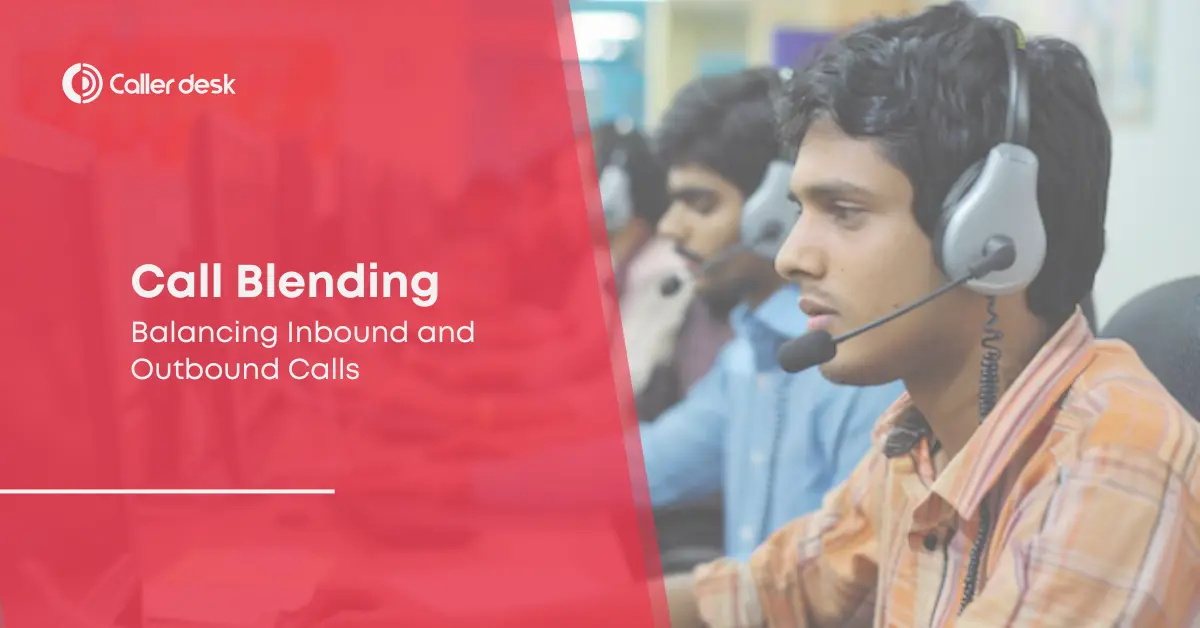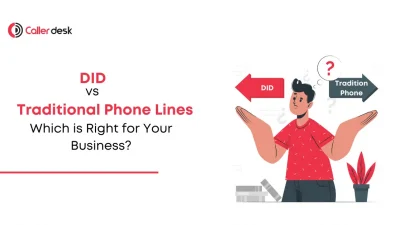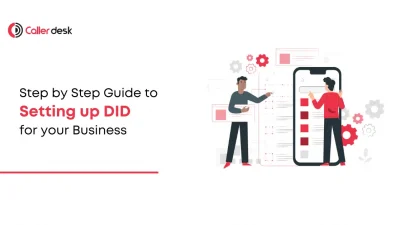The call center industry plays a pivotal role in shaping customer experiences and driving business growth. However, achieving an efficient balance between inbound calls (customer inquiries or support requests) and outbound calls (sales, surveys, or follow-ups) is often a challenge for many businesses.
Traditional call centers often separate agents into inbound and outbound roles, leading to underutilized resources during low traffic periods and overburdened agents during peak times. Enter call blending, a revolutionary strategy that empowers agents to handle both inbound and outbound calls seamlessly, ensuring optimal resource utilization and better service delivery.
With the growing need for efficiency and flexibility, call blending has become a critical component of modern call center operations. By integrating advanced technology like CallerDesk’s smart call routing solutions, businesses can dynamically allocate workloads and maximize productivity.
In this blog, we’ll delve into what call blending is, how it works, the benefits and challenges it presents, and how businesses can leverage tools like CallerDesk to transform their call center operations.
What is Call Blending and How Does It Work?
Call blending is the practice of enabling agents to manage both inbound and outbound calls within a unified workflow. Unlike traditional setups where agents are assigned fixed roles, call blending allows agents to switch tasks dynamically based on real-time demand.
How It Works:
- Dynamic Allocation: Using smart call blending software, calls are routed based on current traffic. For instance, during peak inbound call periods, agents focus on answering customer queries. When inbound call volumes decrease, agents shift to outbound tasks like sales outreach or customer follow-ups.
- Seamless Integration: Call blending systems integrate with CRMs, analytics tools, and omnichannel platforms to ensure agents have access to all necessary information in one place.
- Real-Time Monitoring: Supervisors can monitor call volumes, agent performance, and customer satisfaction metrics, allowing them to make data-driven adjustments as needed.
Example: During a product launch, a retail call center might experience a surge in inbound calls. Call blending ensures that all available agents focus on addressing customer inquiries, while outbound campaigns are temporarily paused.
The Key Benefits of Call Blending
1. Maximized Agent Productivity
Idle agents are a costly inefficiency for any call center. Call blending eliminates idle time by dynamically assigning tasks, ensuring agents are always engaged.
Case in Point: A healthcare call center uses call blending to handle inbound patient inquiries during busy mornings and outbound appointment reminders during quieter afternoons, keeping agents productive throughout the day.
2. Enhanced Customer Satisfaction
By prioritizing inbound calls during high-traffic periods, businesses can reduce wait times and address customer issues more promptly. A quick response translates to improved customer satisfaction and loyalty.
3. Boosted Revenue Opportunities
Call blending creates opportunities for cross-selling and upselling during inbound calls. Outbound calls, meanwhile, can focus on lead generation and closing sales. This dual focus ensures every customer interaction contributes to revenue growth.
Pro Tip: Use CallerDesk’s real-time customer data integration to provide personalized product recommendations during calls, boosting conversion rates.
4. Streamlined Operations
A unified team handling both inbound and outbound tasks reduces the need for separate teams, simplifying workflows and lowering operational costs. Call blending also ensures that no customer query or sales lead falls through the cracks.
5. Improved Agent Morale
Monotony in tasks can lead to burnout. Call blending introduces variety into an agent’s daily routine, keeping their work engaging and reducing attrition rates.
Challenges of Call Blending
While call blending offers numerous advantages, it’s not without its challenges. Addressing these challenges is key to successful implementation:
1. Skillset Adaptability
Agents must be adept at handling both inbound queries and outbound sales or follow-ups. Without the right training, service quality may suffer.
Solution:
- Implement comprehensive training programs focusing on both customer service and sales skills.
- Use CallerDesk’s performance tracking tools to identify skill gaps and offer targeted coaching.
2. Disruption in Workflow
Frequent switching between inbound and outbound tasks can disrupt an agent’s focus, potentially impacting their efficiency.
Solution:
- Use intelligent task allocation tools to minimize unnecessary task-switching.
- Provide agents with real-time guidance to streamline transitions.
3. Dependence on Technology
Call blending heavily relies on advanced software and stable infrastructure. A glitch in the system can disrupt operations.
Solution:
- Partner with a reliable platform like CallerDesk, which offers robust infrastructure, 24/7 support, and advanced failover mechanisms to ensure uninterrupted service.
Key Features to Look for in Call Blending Software
Choosing the right software is critical to implementing call blending effectively. Here’s what to look for:
1. Smart Call Routing
Automatically routes calls to the most qualified agents based on their skills, availability, and workload.
2. Omnichannel Integration
Enables agents to manage interactions across phone, chat, email, and social media from a unified interface, providing a seamless customer experience.
3. Real-Time Analytics
Access detailed insights into call volumes, agent performance, and customer satisfaction to make data-driven decisions.
4. Scalability
As your business grows, the software should easily adapt to accommodate increased call volumes and additional agents.
Real-World Applications of Call Blending
1. Retail
During seasonal sales, retail call centers experience a surge in customer queries. Call blending allows agents to handle inbound inquiries while following up on abandoned carts through outbound calls.
2. Healthcare
Healthcare providers can use call blending to manage appointment scheduling during peak hours and conduct patient follow-ups during downtime.
3. Financial Services
Banks can leverage call blending to provide quick support for account inquiries while using outbound calls for loan promotions or investment opportunities.
Why Choose CallerDesk for Call Blending?
CallerDesk offers an advanced call blending platform designed to transform your call center into a highly efficient and customer-focused operation.
Key Features of CallerDesk’s Call Blending Solution:
- Dynamic Workload Allocation: Automatically adjusts agent workloads based on real-time demand.
- Unified Omnichannel Platform: Manage all customer interactions from a single interface.
- Advanced Analytics: Track performance metrics to identify trends and optimize operations.
- Scalable and Flexible: Easily add new agents or communication channels as your business grows.
- Enhanced Security: Protect sensitive customer data with industry-leading encryption and compliance protocols.
Success Story: A tech company using CallerDesk reduced customer wait times by 50% while increasing outbound sales productivity by 30%, demonstrating the true potential of call blending.
Conclusion
Call blending is the future of call center operations, enabling businesses to balance inbound and outbound calls effectively. By reducing idle time, improving customer satisfaction, and boosting revenue opportunities, call blending is a game-changer for modern contact centers.
With CallerDesk’s advanced call blending solutions, businesses can achieve seamless operations, happier agents, and superior customer experiences. Ready to transform your call center?
Contact CallerDesk today to schedule a free demo and discover how call blending can revolutionize your operations.



